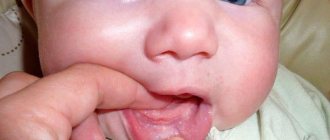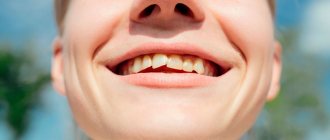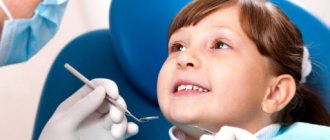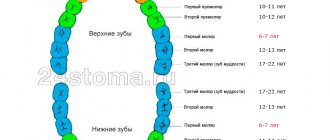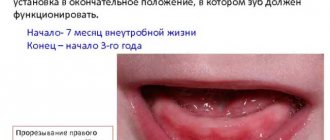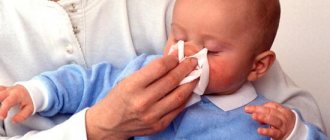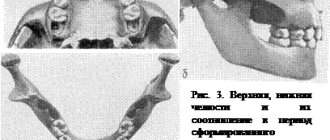Teeth are bone formations, 80% consisting of dentin (hard inorganic tissue). The upper part of the dentin is covered with a dental crown, and the neck of the tooth and its root are surrounded by cement - hard fibers necessary to fix the tooth in the bone alveolus. A person needs teeth for grinding, grinding and chewing food, for the proper formation of the maxillofacial apparatus, consisting of bone tissue and muscles, as well as for speech function. In total, a person has 32 teeth, 4 of which are wisdom teeth and erupt in adulthood or do not appear at all.
Signs of teething in a baby
Baby teeth begin to emerge through the soft layers of gums between 4 and 7 months of age. This process is quite painful and may be accompanied by inflammation, swelling and other symptoms. In some cases, it may be necessary to use painkillers, anti-inflammatory drugs and medications for symptomatic therapy, so it is better to purchase everything you need in advance. You can understand that a child will soon have his first tooth by the characteristic signs that appear in 90% of babies in the first year of life.
Timing of teething
The first "bells"
The first signs of rapid teething are quite vague, but after observing the child for several days, you can notice changes in his well-being and behavior. Most babies begin to act restless, wake up more often at night, and eat less milk or formula about 4 weeks before the central incisors (these teeth appear first in children) erupt.
Baby teething
During this period, behavioral changes can be noted, listed in the table below.
Table. Changes in behavior during teething.
| Action | Why does the child behave this way? |
| Constantly puts toys, edges of clothing, and other objects he can reach into his mouth | This is explained by severe itching in the place where the tooth should appear: the top of the tooth rests on the gum, trying to break through the mucous tissue, and injures it, causing severe irritation. |
| More often requires the breast or asks to be held | Such behavioral changes are especially pronounced in breastfed children due to stronger emotional contact with their mother. For an infant, the breast is not only a source of food, but also a means of comfort, therefore, when experiencing pain and discomfort, the child instinctively looks for an object that he associates with positive emotions. For bottle-fed babies or mixed-fed babies, this item can be a bottle of milk or a pacifier. |
| Refuses to eat complementary foods, even if he previously ate them with pleasure | The explanation for the temporary refusal of foods introduced into the children's diet is due to physical discomfort and unpleasant sensations when the gums touch a spoon or other cutlery. If you give your child a raw apple or carrot during this period, most likely he will try to chew them with pleasure, since such movements provide gum massage and help soothe pain. This method must be used strictly under adult supervision due to the risk of accidental inhalation of small pieces! |
Changes during this period also affect children's sleep. Most babies fall asleep well, but begin to wake up frequently at night to breastfeed. It is impossible to fight this phenomenon - sleep returns to normal after the eruption of the frontal incisors and canines, which are the most painful. To relieve pain, you can use special gels with analgesic properties, for example, “Kamistad Baby” or “Kalgel”. They will also help reduce inflammation caused by trauma to the gums from the sharp tip of an erupting tooth.
"Kamistad Baby"
Important! If during a night's sleep a child wakes up too often, cannot fall asleep for a long time, and each rise is accompanied by a bout of severe crying, it is necessary to consult a doctor to rule out pathologies of the digestive system and other internal organs.
Severe crying during teething
Typical clinical picture: characteristic symptoms
Classic signs of teething in infants occur approximately 10-14 days before the tip of the upper or lower incisor appears on the gum surface. They are difficult not to notice, as they are of high intensity and affect the general well-being of the child. Parents should be aware of all these signs and symptoms in order to take timely measures and provide the necessary hygienic care and medication if needed.
Swelling and itching of the gums are the first signs of rapid tooth eruption.
Increased activity of the salivary glands
This is manifested by hypersalivation - increased salivation. During this period, the child has to be changed every 1.5-2 hours, as his clothes quickly become damp due to constantly flowing drool. Increased attention should be paid to hygiene: a humid environment causes irritation on the skin of the chin and neck and promotes the spread of pathogenic bacteria. A child with excessive drooling should be bathed daily, sometimes even 2 times a day. It is advisable to add a decoction of string or chamomile to the water (you can use regular table salt) - they will relieve inflammation, soothe the skin and eliminate itching.
- Symptoms of teething in infants: how to recognize and respond correctly
Increased salivation
Note! Secretory activity in some children may also be manifested by watery or mucous discharge from the nose. They should have a transparent color and liquid consistency. There is no need to worry about this phenomenon if the child has no signs of colds or respiratory diseases.
Change in body temperature
The appearance of the first teeth is a difficult process for a child’s body, accompanied by inflammation, to which the immune system reacts with a slight increase in body temperature. Usually this indicator remains within subfebrile values and does not exceed 38°C. If the child feels well, there is no need to lower the temperature. In case of severe discomfort, when the child refuses to eat and is not interested in surrounding objects and people, you can use drugs from the group of antipyretic drugs.
Temperature during teething
The drugs of choice for children under 1 year of age are those containing paracetamol or ibuprofen. They can be produced in the form of rectal suppositories or syrups for internal use. These include:
- "Ibufen";
- "Panadol";
- "Nurofen";
- "Paracetamol";
- "Ibuprofen."
Important! For children with a tendency to allergic reactions, it is better to use the drug in the form of suppositories (for example, Cefekon), since the oral forms contain aggressive dyes.
"Cefekon"
External gum changes
The surest way to determine that a child's teeth will begin to grow is to examine his gums. There is a whole range of symptoms that allow you to determine the imminent eruption. These include:
- swelling and swelling of the gums;
- the appearance of a white dense lump on the gum (the upper part of the erupting tooth), when pressed on which the child experiences severe pain;
- hyperemia of the mucous membranes at the site of eruption;
- itching of soft tissues (if a child scratches an inflamed gum, he will close his jaw tightly and make scratching movements);
- bleeding gums.
Gums during teething
If the gums begin to bleed, it means that there is very little left until the first tooth erupts - no more than 3-7 days.
Important ! These symptoms may indicate inflammatory gum disease, such as gingivitis or periodontitis. Despite the fact that they are rarely diagnosed in children in the first year of life, it is necessary to consult a dentist to rule them out. A white lump on the gum may be an abscess or abscess, so it is best to draw conclusions about the causes of the inflammatory process after a medical examination.
Baby's first teeth
Panadol
Panadol (pharmacologically active substance - paracetamol) is a non-narcotic analgesic with analgesic, antipyretic and minor anti-inflammatory effects. Analgesics are the most popular group of drugs today. This is quite logical, because There is hardly a more unpleasant symptom than pain. In this regard, it is vital for doctors to have tools for effective pain management in their arsenal. It is surprising, however, that given the current size of the pharmaceutical market, there are only three classes of drugs that have a direct analgesic effect: non-steroidal anti-inflammatory drugs (NSAIDs), opioid analgesics and, in fact, paracetamol (Panadol). Each group, naturally, has its own advantages and disadvantages. At the same time, in the USA and Western European countries, paracetamol is the first choice drug for the relief of mild and moderate pain. This drug began to be used in clinical practice in the mid-50s of the last century, and for more than 60 years it has remained perhaps the most popular over-the-counter pain reliever. Without the risk of making a mistake, you can predict what drug a doctor in any developed country will prescribe for toothache, back pain or headaches - Panadol. This is not to say that analgesics from other groups are completely worthless. The same NSAIDs are extremely popular throughout the world, especially in cases where pain is caused by inflammation or tissue damage. Their undeniable advantages are proven effectiveness, studied and predictable pharmacological action, and financial accessibility for the general public. However, on the other side of the scale there is an obvious risk of developing unwanted side effects, the main of which is the so-called “NSAID gastropathy” (erosive and ulcerative lesions of the upper gastrointestinal tract). The incidence of serious gastrointestinal disorders while taking NSAIDs is approximately 1 case per 100 patients. Patients who are on NSAIDs for a long time are 2-3 times more likely to die from bleeding in the gastrointestinal tract than people who do not receive NSAIDs (or take them in small doses).
“Mild” non-narcotic opioid painkillers are also quite effective analgesics that directly affect the antinociceptive system and prevent the transmission of pain impulses. These drugs (mainly codeine-containing ones) are widely used in the USA and Western European countries. In Russia, their choice is limited, in fact, to only one drug - tramadol, included in the list of potent drugs, which does not have the best effect on its availability. In addition, opioid analgesics have never been well tolerated. Panadol, in turn, has a specific mechanism of action that differs from NSAIDs and opioids. It is believed that this drug is able to inhibit the activity of cyclooxygenase (COX), thereby suppressing the synthesis of pro-inflammatory prostaglandins. However, unlike the same NSAIDs, which act mainly on COX-2, panadol “turns off” COX-3, which “trades” mainly in the central nervous system. In other words, the analgesic and antipyretic effect of panadol is central. Summarizing all of the above, it is necessary to note the good tolerability of paracetamol, which is the key advantage of this drug over other analgesics. Thus, unlike NSAIDs, the use of Panadol is not accompanied by a significant increase in the risk of developing gastrointestinal and cardiovascular complications, which allows the drug to be prescribed to patients with risk factors. This is extremely relevant, for example, in the treatment of patients with chronic rheumatic diseases, since these are mainly elderly people with a lot of concomitant pathologies. The risk of developing complications from the liver and kidneys while using Panadol is also extremely low. Moreover: the drug is successfully used in patients with renal and liver failure.
Pathological signs: when should you see a doctor?
Some symptoms that young mothers consider normal during teething are not directly related to the process and are the penetration of infection into the child’s body. Teething is stressful for the body, and the child’s immunity during this period is greatly weakened, which creates excellent conditions for the growth of pathogenic bacteria and viruses.
Teething is often quite painful
Listed below are typical signs that require consultation with a specialist, which cannot be considered as a physiological norm during the appearance of baby teeth in infants.
- Temperature . A slight increase in temperature is considered normal during the eruption of frontal incisors and canines, but it should not rise above the upper limits of subfebrility. If a child has a temperature of 38.1°C or higher, you should consult a doctor - an infection has probably occurred due to reduced immunity.
- Diarrhea. It is normal to loosen stools due to increased activity of the endocrine glands, but stools should not be too frequent, watery, or foul-smelling. There should be no changes in the color of the stool, so consultation with a doctor is necessary if the stool has changed consistency, color or smell.
Diarrhea during teething
- Cough . The physiological norm is a slight cough that occurs as a result of saliva flowing down the back wall of the larynx, but a frequent and prolonged cough always indicates a cold infection.
Child at the doctor
Any changes in the child’s well-being and behavior should be a reason for consultation with a pediatrician or pediatric dentist - only a doctor will be able to assess the baby’s condition and draw a conclusion about his health and the need for any therapy. Read the article for treatment of stomatitis at home.
Panadol for teething
This is an effective drug that combats pain during teething in children. Available in two types: syrup and candles. The active substances include paracetamol, which works well in reducing fever and eliminating pain.
The advantage of this product is that its use is possible from the age of three months.
Only a doctor can tell you what form is best to use the drug. Several forms of medication are very convenient. Syrup can cause a gag reflex in some babies. In this case, there is no need to look for any other drugs, just use suppositories.
Panadol Baby syrup / Panadol baby
Available in a dark bottle of 100 ml. Recommended age of use: from 2 months to 12 years. The kit includes a dispenser in the form of a syringe, which greatly helps to control the dosage.
The suspension itself has a very viscous structure, reminiscent of jelly in appearance. It has a strawberry aroma and pinkish-red color. The taste is quite pleasant.
It is very important to remember that although the product looks like a tasty jelly, it is a medicinal drug, the abuse of which is highly not recommended.
The packaging states that if there are no therapeutic effects, you should stop taking it without increasing the dose and consult a pediatrician.
Panadol suppositories for children
Produced in the form of suppositories, this medicine is a good helper in the fight against pain and fever. These are whitish cone-shaped suppositories that do not have any strong odor. In normal condition, there are no defects or foreign impurities on their surface.
Packed in strips of 5 or 10 pieces. In total, one package contains from 5 to 20 candles.
